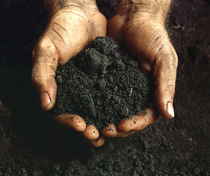
California Symbols
California State Soil
San Joaquin soil series

Adopted on August 20, 1997
San Joaquin soil series was designated the official state soil of California in 1997 through the efforts of students and teachers at Martin Luther King, Jr. Middle School in Madera, natural resource professionals, the Professional Soil Scientists Association of California, legislators, and several state universities. The designation commemorates the completion of the state's most comprehensive soil inventory and acknowledges the importance of soil. A profile of San Joaquin soil is displayed at the World Soil Museum in the Netherlands. San Joaquin soil became "the official State Soil" when Senate Bill No. 389 was signed into law by Governor Wilson on August 20, 1997.
California State Soil: San Joaquin Soil Series
 California's Great Central Valley has more
than 500,000 acres of San Joaquin soils, named for the south end of that valley. This series is the oldest continuously recognized
soil series within the State. It is one of California's Benchmark Soils, and a profile of it is displayed in the Netherlands World Soil Museum.
California's Great Central Valley has more
than 500,000 acres of San Joaquin soils, named for the south end of that valley. This series is the oldest continuously recognized
soil series within the State. It is one of California's Benchmark Soils, and a profile of it is displayed in the Netherlands World Soil Museum.These soils are used for irrigated crops, such as wheat, rice, figs, almonds, oranges, and grapes, and for pasture and urban development. San Joaquin soils formed in old alluvium on hummocky topography. A cemented hardpan a few feet beneath the surface restricts roots and water percolation.
Profile
Surface layer: brown loam
Subsoil - upper: brown loam
Subsoil - lower: brown clay
Substratum: light brown and brown, indurated duripan with 70 to 90 percent silica-sesquioxide cementation
SAN JOAQUIN SERIES
The San Joaquin series consists of moderately deep to a duripan, well and moderately well drained soils that formed in alluvium derived from mixed but dominantly granitic rock sources. They are on undulating low terraces with slopes of 0 to 9 percent. The mean annual precipitation is about 15 inches and the mean annual temperature is about 61 degrees F.
TAXONOMIC CLASS: Fine, mixed, active, thermic Abruptic Durixeralfs
SERIES ESTABLISHED: Fresno County, California, 1900.
California SENATE BILL No. 389
Introduced by Senator Monteith
(Coauthor: Assembly Member House)
February 14, 1997
An act to add Section 425.9 to the Government Code,relating to the official state soil.
LEGISLATIVE COUNSEL'S DIGEST
SB 389, as introduced, Monteith. Official State Soil.
This bill would express legislative intent to commemorate the completion of the state's most comprehensive soil inventory, as conducted by specified
entities, by designating an official State Soil. The bill would designate San Joaquin Soil as the official State Soil, and would make legislative findings
and declarations in support of that designation.
Vote: majority. Appropriation: no. Fiscal committee: no.
State-mandated local program: no.
The people of the State of California do enact as follows:
SECTION 1. It is the intent of the Legislature to commemorate the completion of the state's most comprehensive soil inventory by the Professional Soil
Scientists Association of California, the California Association of Resource Conservation Districts, the national Resources Conservation Service, and
students and teachers of the Martin Luther King, Jr. Middle School in Madera, California, California, by adopting an official state soil, for the following
reasons:
(a) To acknowledge the importance of the state's agricultural heritage and historic legacy, since soil is the keystone to agribusiness in California.
(b) To acknowledge the importance of soil and the many benefits derived from it in everyday life.
(c) To establish a standard to which educators may compare other soils.
(d) To acknowledge the need for stewardship of the soil, and expose the public to conservation of one of the state's most valuable resources.
(e) To promote awareness on the part of the general public of the complex dynamics of the state's ecosystem.
SEC. 2. Section 425.9 is added to the Government
Code, to read:
425.9. (a) The Legislature finds and declares that San Joaquin Soil is the essence of California. It covers over 50,000 acres of the state, and is
one of four soils to be originally described at the beginning of this century, and the beginning of soil studies in California. San Joaquin Soil is
approximately 50,000 to 250,000 years old and was derived from and deposited by the runoff of swollen streams during the glacial period, from mountain
glaciers in the Sierra Nevada. It is unique in that it supports the mima mound topography, which is a geomorphic feature of hillock or hummocky terrain,
and California is one of the few places in the world where this feature occurs.
(b) The Legislature hereby designates San Joaquin Soil as the official State Soil.
California Law
The law designating the San Joaquin Soil as the official California state soil is found in the California Government Code, specifically Title 1, Division 2, Chapter 2, Section 425.9.
CALIFORNIA GOVERNMENT CODE
TITLE 1. GENERAL
DIVISION 2. STATE SEAL, FLAG, AND EMBLEMS
CHAPTER 2. STATE FLAG AND EMBLEMS
SECTION 420-429.8
425.9. (a) The Legislature finds and declares that San Joaquin Soil is the official soil of California. It is one of four soils to be originally described
at the beginning of this century, and the beginning of soil studies in California. San Joaquin Soil is approximately 50,000 to 250,000 years old and
was derived from and deposited by the runoff of swollen streams during the glacial period, from mountain glaciers in the Sierra Nevada.
(b) The Legislature hereby designates San Joaquin Soil as the official State Soil.






